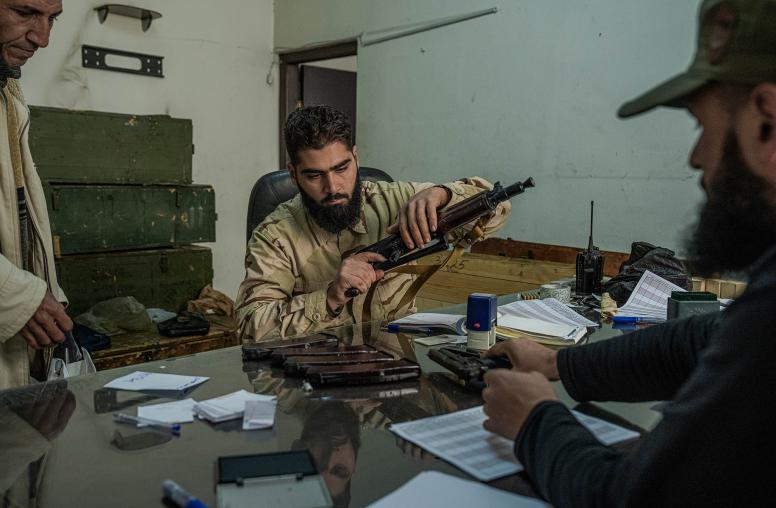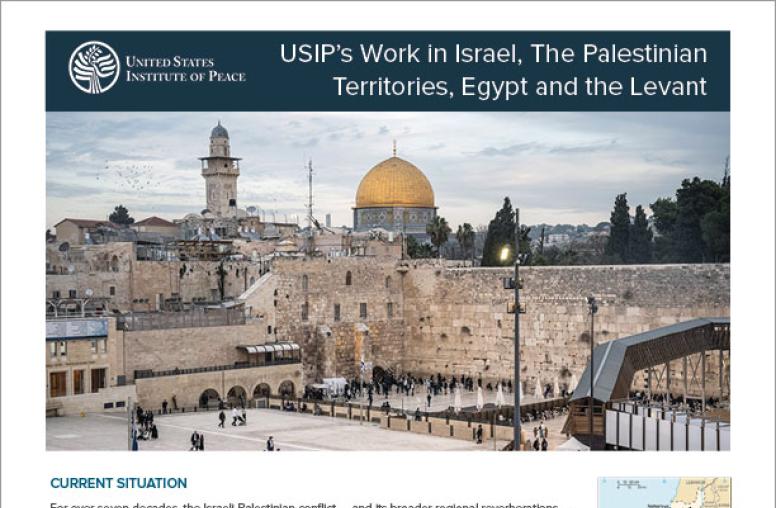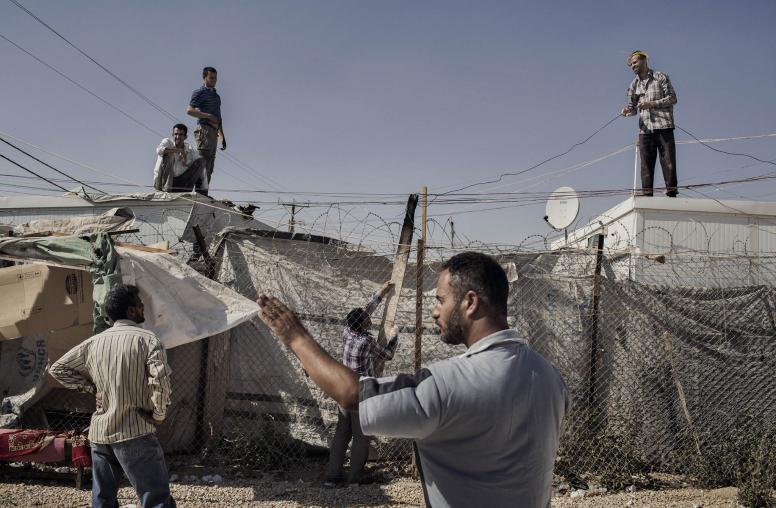Syria: Regional Fallout from the Civil War
Part of USIP’s series on sleeper risks
In the first in a USIP series on “sleeper risks” in 2013, possible regional effects of Syria’s civil war are examined. If the regime of Bashar Al-Assad falls back into an Alawite-dominated area under intensifying rebel pressure, the fragmentation of the Syrian state could encourage Kurdish and other separatism, raising questions about the post-Ottoman state system in the Levant.

 Many of the clearest risks of conflict, violence and instability around the world have received widespread media attention. But a variety of other risks and threats have been smoldering quietly. The United States Institute of Peace (USIP) is engaged in a variety of peacebuilding and conflict management efforts in many of the countries where these lesser-known risks are emerging. In a series of articles, the Institute examines some of these “sleeper risks” through the analytical lens of USIP experts. | Read more about USIP’s series on sleeper risks
Many of the clearest risks of conflict, violence and instability around the world have received widespread media attention. But a variety of other risks and threats have been smoldering quietly. The United States Institute of Peace (USIP) is engaged in a variety of peacebuilding and conflict management efforts in many of the countries where these lesser-known risks are emerging. In a series of articles, the Institute examines some of these “sleeper risks” through the analytical lens of USIP experts. | Read more about USIP’s series on sleeper risks
As a coalition of rebel forces presses its fight against the regime of Bashar al-Assad, Syria watchers are divided as to whether the regime will, at some point, fully disintegrate or, rather, will abandon most of its remaining areas and regroup into a much smaller, Alawite-dominated swath of the country, rallying around fellow Alawite Assad. With better weaponry and organization, the rebels are likely to make further advances, meaning that one of those two scenarios may well play out in 2013.
USIP Special Adviser for Middle East Initiatives Steven Heydemann calls the latter scenario one of “incremental, phased collapse”: pro-regime forces consolidating their defenses in a territory along the Mediterranean Sea that would likely include the urban centers of Latakia and Tartus. This is the de facto homeland of Syria’s Alawites, an offshoot of Shia Islam that includes some 10 percent of the country’s population but, through the Assad family, has held a privileged place in Syria for decades and dominated its political and security spheres.
Fearing retribution, many of Syria’s Alawites are backing the regime with the zeal of people who believe that their backs are against the wall. Such a phased collapse could prolong the country’s vicious civil war for a significant, if unknown, period of time; Heydemann calls it “the $64,000 question.” How long it lasts would in part depend on the truncated regime’s military resources and on the support it receives from allies in Iran and Lebanon, as well as from Russia.
Such a phased collapse presents a known risk for extended conflict in 2013. But the possible consequences of a phased collapse on the region have not received much attention, and could spawn nasty surprises and more violence in the months and years to come.
“Fundamental questions could be opened up,” said Heydemann. “Such a collapse could reopen the issue of the post-Ottoman state system in the Levant."
With the demise of the Ottoman Empire in World War II, the victorious powers led by Great Britain and France won mandates to govern—and draw the borders of—what would later become Lebanon, Syria, Iraq, and Jordan. The post-Ottoman lines politically separated traditional ethnic and religious groups, particularly the Kurds, into different entities. "Despite frequent claims about the fragility and artificiality of the state system in the Middle East," Heydemann noted, "modern Syria is the result of a political settlement that has held for nearly 100 years. Reopening this post-Ottoman settlement now would have huge spillover effects, potentially threatening the integrity of Iraq and sparking conflicts between Kurds and Turkey.”
Heydemann is concerned that a de facto Alawite entity could encourage some of Syria’s minority groups—especially the Kurds, who predominate in the country’s northeast—to seize control over their own areas, including demanding full autonomy from a post-Assad government.
The Kurds, about 10 percent of Syria's population, have long suffered displacement from their lands, discrimination and impoverishment at the hands of the Assad family. For decades, the Baathist regimes of Hafiz and Bashar al-Assad denied citizenship to hundreds of thousands of Kurds who could trace their presence in Syria back hundreds of years. Though few Syrian Kurds give outright support to the Assad regime, they have shown concern over the possibility that they could again find themselves marginalized in a post-Assad state. As a result, the Syrian uprising has been accompanied by a groundswell of support among Kurds for a political system in which they would receive a significant level of autonomy. They have also been receiving support from fellow Kurds in Iraq through the Kurdistan Regional Government.
“We could see the fragmentation of the Syrian state,” said Heydemann, who has directed USIP’s “The Day After” project, an effort to facilitate the development of a post-Assad transition plan that was designed and led by leading members of the Syrian opposition. “Neither the U.S. nor regional actors have really planned for such a possibility, even though all of them understand that it might occur, with potentially disastrous consequences."
Those consequences could quickly spill into Turkey, which is opposed to Kurdish separatism anywhere in the region. It has fought against guerrillas from the Kurdistan Workers’ Party, known as the PKK, for decades. Assad responded to Turkish backing for Syrian rebels by allowing a PKK-linked group in Syria to send fighters and other support into Turkey. Turkey might be counted on to react strongly to autonomy for neighboring Syrian Kurds.
The Kurds of Iraq might also look for ways to strengthen the defenses of Syria’s Kurds, perhaps deepening current tensions between Iraqi Kurds and the Arab-Shia forces that dominate its central government. And if Syria’s Kurds can force a change in their status, other minorities in the region may feel encouraged to try a similar course, leading to renewed separatist conflicts.
"What we could find," said Heydemann, “is that the regionalization of the Syrian revolution could include not only the intrusion of regional actors into the messy and violent politics of post-Assad Syria, but also the export of destabilizing factors opened up by the Syrian revolution to much of the surrounding region."
Explore Further
- The Day After Project: Supporting a Democratic Transition in Syria
- Syria and "The Day After Project"
On the Issues by Steven Heydemann - Syria | Countries and Regions
Read Features in This Series
- Nuclear Nonproliferation: A Corroding International Regime (January 31, 2013)
- The Israeli-Palestinian Standoff: More Risks Emerging (February 5, 2013)
- Jordan Election Turnout Masks Risk of Shaky Economy and King’s Restive Base (February 7, 2013)
- Sudan: Economic Pressures Building (February 12, 2013)
- South Sudan: Undemocratic Tendencies on the Rise (February 14, 2013)
- Pakistan’s Militant, Nuclear Threats Mask Underlying Risk: Water (February 19, 2013)
- Afghanistan Land Conflicts Pit Nomads Against Villagers, Power Brokers Against Each Other (February 21, 2013)


